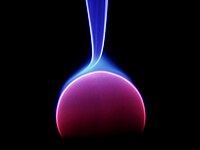
Tackling Energy Loss for High-Efficiency Organic Solar Cells with Integrated Multiple Strategies.
Sign Up to like & getrecommendations! Published in 2018 at "Advanced materials"
DOI: 10.1002/adma.201706816
Abstract: Limited by the various inherent energy losses from multiple channels, organic solar cells show inferior device performance compared to traditional inorganic photovoltaic techniques, such as silicon and CuInGaSe. To alleviate these fundamental limitations, an integrated… read more here.
Keywords: organic solar; energy; solar cells; loss ... See more keywords

Donor End‐Capped Alkyl Chain Length Dependent Non‐Radiative Energy Loss in All‐Small‐Molecule Organic Solar Cells
Sign Up to like & getrecommendations! Published in 2022 at "Advanced Materials"
DOI: 10.1002/adma.202207020
Abstract: A critical bottleneck for further efficiency breakthroughs in organic solar cells (OSCs) is to minimize the non‐radiative energy loss (eΔVnr) while maximizing the charge generation. With the development of highly emissive low‐bandgap non‐fullerene acceptors, the… read more here.
Keywords: energy loss; organic solar; solar cells; energy ... See more keywords

Revealing the Sole Impact of Acceptor's Molecular Conformation to Energy Loss and Device Performance of Organic Solar Cells through Positional Isomers
Sign Up to like & getrecommendations! Published in 2022 at "Advanced Science"
DOI: 10.1002/advs.202103428
Abstract: Two new fused‐ring electron acceptor (FREA) isomers with nonlinear and linear molecular conformation, m‐BAIDIC and p‐BAIDIC, are designed and synthesized. Despite the similar light absorption range and energy levels, the two isomers exhibit distinct electron… read more here.
Keywords: energy loss; molecular conformation; acceptor; baidic ... See more keywords

Simple Bithiophene–Rhodanine‐Based Small Molecule Acceptor for Use in Additive‐Free Nonfullerene OPVs with Low Energy Loss of 0.51 eV
Sign Up to like & getrecommendations! Published in 2019 at "Advanced Energy Materials"
DOI: 10.1002/aenm.201804021
Abstract: The introduction of rigid and extended ladder‐type fused‐ring cores, such as indacenodithiophene, has enabled the synthesis of a variety of nonfullerene small molecules for use as electron acceptors in high‐performance organic photovoltaic cells. Contrasting with… read more here.
Keywords: energy; acceptor; energy loss; nonfullerene ... See more keywords

Reducing energy loss in organic solar cells by changing the central metal in metalloporphyrins.
Sign Up to like & getrecommendations! Published in 2020 at "ChemSusChem"
DOI: 10.1002/cssc.202002664
Abstract: The effect of central donor core on the properties of A-π-D-π-A donors where D is a porphyrin macrocycle was investigated for the fabrication of the organic solar cells, along PC 71 BM as electron acceptor.… read more here.
Keywords: organic solar; vc9; energy; energy loss ... See more keywords

Energy loss by right ventricular pacing: Patients with versus without hypertrophic cardiomyopathy
Sign Up to like & getrecommendations! Published in 2021 at "Journal of Arrhythmia"
DOI: 10.1002/joa3.12472
Abstract: Right ventricular (RV) pacing causes left ventricular (LV) dyssynchrony sometimes resulting in pacing‐induced cardiomyopathy. However, RV pacing for hypertrophic obstructive cardiomyopathy is one of the treatment options. LV flow energy loss (EL) using vector flow… read more here.
Keywords: hypertrophic cardiomyopathy; energy loss; right ventricular; ventricular pacing ... See more keywords

Inelastic scattering and energy loss of swift electron beams in biologically relevant materials
Sign Up to like & getrecommendations! Published in 2017 at "Surface and Interface Analysis"
DOI: 10.1002/sia.5947
Abstract: The authors acknowledge financial support by the Spanish Ministerio de Economia y Competitividad (Project FIS2014-58849-P). IK and DE acknowledge financial support from the European Union FP7 (Marie Curie Actions) program “RADDEL” (REA grant agreement No.… read more here.
Keywords: loss swift; energy loss; electron beams; inelastic scattering ... See more keywords

Comparison of the Mermin and Penn models for inelastic mean‐free path calculations for electrons based on a model using optical energy‐loss functions
Sign Up to like & getrecommendations! Published in 2019 at "Surface and Interface Analysis"
DOI: 10.1002/sia.6628
Abstract: We present detailed comparisons of calculated inelastic mean‐free paths (IMFPs) of electrons with energies up to 10 keV from the full Penn algorithm (FPA) model and the Mermin model using prototypical Drude‐type energy‐loss functions (ELFs).… read more here.
Keywords: energy; energy loss; model using; model ... See more keywords

Examining Different Regimes of Ionization-Induced Damage in GaN Through Atomistic Simulations.
Sign Up to like & getrecommendations! Published in 2022 at "Small"
DOI: 10.1002/smll.202102235
Abstract: The widespread adoption of gGaN in radiation-hard semiconductor devices relies on a comprehensive understanding of its response to strongly ionizing radiation. Despite being widely acclaimed for its high radiation resistance, the exact effects induced by… read more here.
Keywords: electronic energy; ionization; examining different; energy loss ... See more keywords
Halogen-Free Donor Polymers Based on Dicyanobenzotriazole with Low Energy Loss and High Efficiency in Organic Solar Cells.
Sign Up to like & getrecommendations! Published in 2023 at "Small"
DOI: 10.1002/smll.202206607
Abstract: Halogenation of organic semiconductors is an efficient strategy for improving the performance of organic solar cells (OSCs), while the introduction of halogens usually involves complex synthetic process and serious environment pollution problems. Herein, three halogen-free… read more here.
Keywords: energy loss; halogen free; donor polymers; efficiency ... See more keywords

Chlorinated Narrow Bandgap Polymer Suppresses Non-Radiative Recombination Energy Loss Enabling Perylene Diimides-Based Organic Solar Cells Exceeding 10% Efficiency.
Sign Up to like & getrecommendations! Published in 2023 at "Small"
DOI: 10.1002/smll.202208217
Abstract: The scarcity of narrow bandgap donor polymers matched with perylene diimides (PDI)-based nonfullerene acceptors (NFAs) hinders improvement of the power conversion efficiency (PCE) value of organic solar cells (OSCs). Here, it is reported that a… read more here.
Keywords: energy loss; efficiency; narrow bandgap;